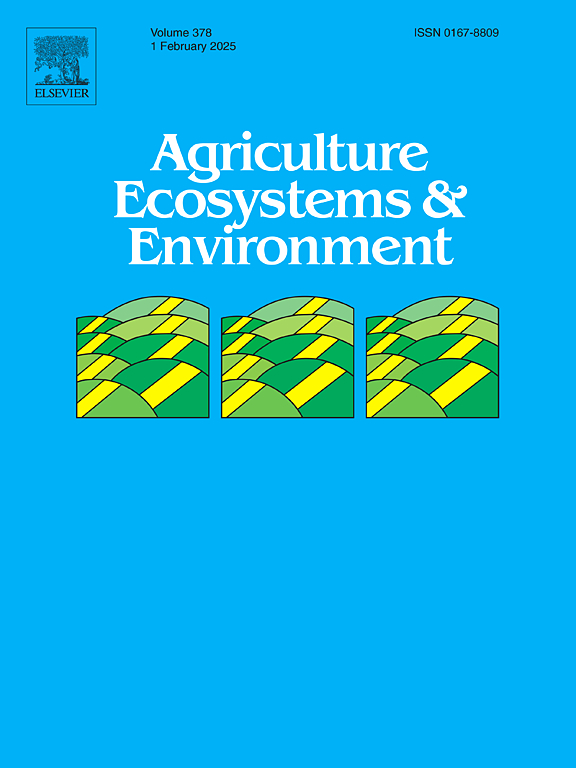基于三年实地观测研究的水分条件引发土壤呼吸对生物炭引起的土壤垂直含水量和温度变化的不同反应模式
IF 6
1区 农林科学
Q1 AGRICULTURE, MULTIDISCIPLINARY
引用次数: 0
摘要
生物炭对土壤呼吸作用(Rs)的影响仍不确定,尤其是在因复湿而产生大量二氧化碳排放的干旱地区。为了研究这些影响,我们在小米生长季节进行了为期三年的田间试验,研究 Rs 对生物炭引起的垂直土壤温度(Ts)和体积含水量(VWC)变化的响应模式。在观测 Rs 之前,实验地进行了三年的生物炭改良(不种植),施用率分别为 1%、2.5%、4%、5.5% 和 7%(BC1、BC2.5、BC4、BC5.5 和 BC7,施用于 0-20 厘米土层)。在 0-20 厘米土层中监测 Rs,同时在 5、10 和 20 厘米土层深度同时测量 Ts 和 VWC(Ts5、Ts10、Ts20、VWC5、VWC10 和 VWC20)。对于未经生物炭改良的土壤(对照),Rs 测量范围内的水分状况按 0.093 立方米/立方米-3(Rs 的最佳 VWC)划分。总体而言,与对照相比,BC4、BC5.5 和 BC7 的 Rs 显著增加(33.3-63.5%),在 5 厘米深的土壤中更早出现水分胁迫。此外,高湿度也会导致各处理间 Rs 的显著差异。就 Rs 与 Ts 之间的关系而言,高斯-Ts 模型比指数-Ts 模型在低水分条件下仅在 5 厘米深的土壤对照中表现更好。就生物炭处理而言,在低湿度条件下,BC1 和 BC2.5 处理的 Rs 不会随着 Ts 的增加而继续上升;在高湿度条件下,BC5.5 和 BC7 处理的 Rs 不会随着土壤深度的增加而继续上升。随着生物炭施用量的增加,在低湿度条件下,Rs主要受VWC20和Ts20的影响,而在高湿度条件下,Rs则明显受Ts的影响。这些发现阐明了 Rs 在不同湿度条件下如何响应生物炭引起的垂直 Ts 和 VWC 的变化,为全面评估生物炭改良土壤对干旱地区的环境影响提供了宝贵的见解。本文章由计算机程序翻译,如有差异,请以英文原文为准。
Moisture conditions trigger different response patterns of soil respiration to biochar-induced changes in soil vertical water content and temperature based on a three-year field observation study
Biochar impacts on soil respiration (Rs) remain uncertain, particularly in dryland regions where significant CO2 emissions result from rewetting. To examine these impacts, we conducted a three-year field experiment during the millet growing season to investigate the response patterns of Rs to biochar-induced changes in vertical soil temperature (Ts) and volumetric water content (VWC). Before Rs observation, the experimental site underwent three years of biochar amelioration (no planting) with five application rates of 1 %, 2.5 %, 4 %, 5.5 % and 7 % (BC1, BC2.5, BC4, BC5.5 and BC7, applied to the 0–20 cm soil layer). Rs was monitored within the 0–20 cm soil layer while Ts and VWC were measured simultaneously at soil depths of 5, 10 and 20 cm (Ts5, Ts10, Ts20, VWC5, VWC10 and VWC20). Moisture status within the Rs measurement range was partitioned by 0.093 m3 m−3 (the optimal VWC for Rs) for non-biochar amended soil (control). Overall, compared with the control, BC4, BC5.5 and BC7 significantly increased Rs (33.3–63.5 %) and experienced water stress earlier at a soil depth of 5 cm. In addition, high moisture levels caused significant differences in Rs among treatments. In terms of the relationship between Rs and Ts, the Gaussian-Ts model performed better than exponential-Ts in control only at a soil depth of 5 cm under low moisture conditions. For biochar treatments, Rs did not continue to rise with increasing Ts for BC1 and BC2.5 treatments under low moisture conditions and for BC5.5 and BC7 treatments under high moisture conditions across soil depths. With biochar application rate, Rs was dominantly shaped by VWC20 and Ts20 under low moisture conditions, while it was significantly influenced by Ts under high moisture conditions. These findings elucidate how Rs responds to biochar-induced changes in vertical Ts and VWC across moisture levels, providing valuable insights for comprehensively evaluating the environmental effects of biochar-amended soil in dryland areas.
求助全文
通过发布文献求助,成功后即可免费获取论文全文。
去求助
来源期刊

Agriculture, Ecosystems & Environment
环境科学-环境科学
CiteScore
11.70
自引率
9.10%
发文量
392
审稿时长
26 days
期刊介绍:
Agriculture, Ecosystems and Environment publishes scientific articles dealing with the interface between agroecosystems and the natural environment, specifically how agriculture influences the environment and how changes in that environment impact agroecosystems. Preference is given to papers from experimental and observational research at the field, system or landscape level, from studies that enhance our understanding of processes using data-based biophysical modelling, and papers that bridge scientific disciplines and integrate knowledge. All papers should be placed in an international or wide comparative context.
 求助内容:
求助内容: 应助结果提醒方式:
应助结果提醒方式:


